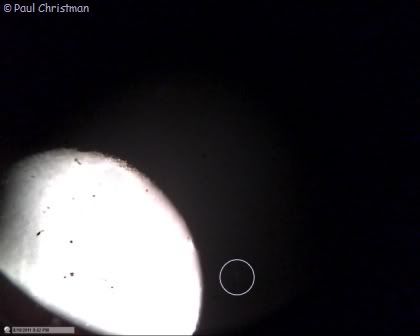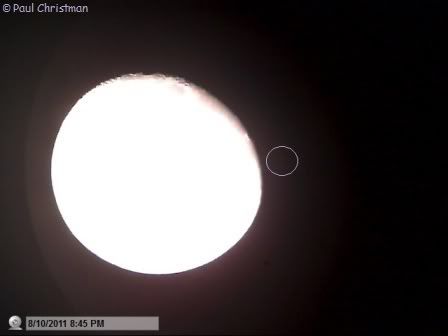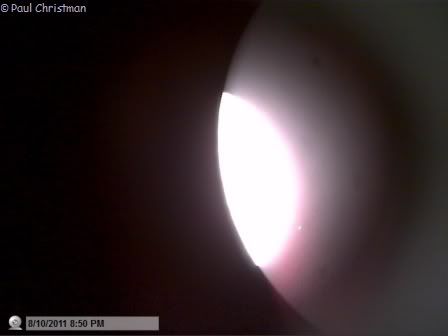Wednesday, August 10, was a work night, so I couldn’t make it to the Chicago Astronomer session. Besides, I wanted to observe the Pi Sagittarii occultation uninterrupted. Hillary wanted to see the occultation too, but the Moon was low, and she has tall trees behind her house. We went to Gilbert Park in Portage for an unobstructed, uninterrupted observation.
My plan was to document the immersion and emersion times through multiple telescopes and cameras. Without practice, though, nothing went according to plan. My 4.5” Newtonian is too badly out of collimation for useful observation at high magnification, but I wanted to use it. I figured I could run my Mead camera to my computer to help keep an eye on Pi Sagittarii while I was away from the eyepiece of my 6” Dob. That probably would have worked, but the batteries were almost dead, and the scope wasn’t tracking properly.
The plan for my Dob was to get pictures with one of my Logitech webcams, since the webcam images have a timestamp. I had forgotten that my testing of the webcam for lunar images hadn’t been good, and wasn’t getting quality images. As a last resort, I was forced to use my Vivitar point and shoot camera, without a timestamp for each image. Something is better than nothing.
As soon as I had the Dob ready to go around 8:30 PM CDST, I could see Pi Sagittarii already near the northeast lunar limb. Hillary could also see it with her 60mm shorty refractor. I didn’t have much time before Curt’s predicted immersio, and was spending more time trying to eliminate problems than observing. As Luna drew ever closer to Pi Sagittarii, I had to focus on getting whatever I could, and be ready to check the time as soon as the star disappeared behind the lunar limb. I had a small window open with a Cartes du Ciel time displayed in CDST, and UTC for my timings.
Webcam images. Not as good as I was hoping they would be.
I was expecting immersion ahead of Curt’s predicted time, and really wanted to get a video of when the star disappeared. When the predicted time rolled around, the star was still visible. I was getting my camera ready for video, but wasn’t shooting yet when I couldn’t see Pi Sagittarii on the video screen anymore. I double checked at the eyepiece, and it was gone. The time was 8:53:50 PM CDST. I took a few pictures of the Moon while the star was occulted, then shut down my computer to save battery, and enjoyed the last of my Dairy Queen chocolate shake.
Pi Sagittarii nearing the dark, leading lunar limb.
I had another set of batteries for my go-to Newt in my astronomy case, but they too were dead, and that scope was rendered useless the rest of the observation. I didn’t do much observing throughout the occultation, and just kind of hung out with Hillary until the emersion time approached. The emersion was behind schedule, and I was diligently watching through my 25mm eyepiece, waiting. I picked it out immediately, and noted the time (on the back of my hand) as 9:51:04 PM CDST. My first sets of images after emersion weren’t very successful, but as the Moon moved further from it, Pi Sagitarii became increasingly easier to capture out of the lunar glare. After only a few minutes of watching the two separate, it was time to pack up, take Hillary home, and go to work.
I thought I was well prepared for a great observation.
Hillary waiting for Pi Sagittarii to emerge from behind the Moon.
Luna during the occultation.
Pi Sagittarii just after emersion.
This was the third time I’ve caught at least part of a lunar occultation. I’ve also timed transits and shadow transits of the Galilean Moons in the Jovian system. I haven’t documented any of them as well as I would like to, but they are all learning experiences. I use these events to help train myself for the BIG ONE, next year’s transit of Venus across the face of the Sun. I’d like to gather scientifically useful data that can be used to measure solar parallax during that event, according to the method of French astronomer Delisle. I think I can do it, and every time I document a lunar occultation or Galilean transit, I hone my skills and methods for that last chance at the Venus transit.



















